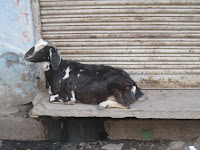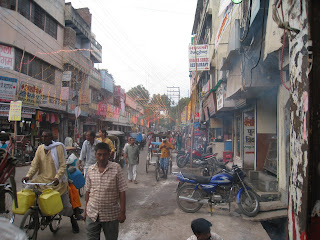Today we say goodbye to Varanasi-Banaras-Kashi and we take off in various groupings for a week of independent travel. Some will go south to Kerala, others to Rajasthan, two to the Andaman Islands and the rest of us to Darjeeling and Gangtok. We meet up on November 4th in Bangalore and begin the last month of the trip exploring the southern part of India.
Varanasi is the strangest place I’ve ever visited. It’s dirty, smelly, and loud. It’s also home to some of the friendliest and most generous people I’ve ever met. The average resident is helpful, interested and fun. They ask us where we’re from and when we tell them, the always smile and say something like “great country” or “we like Obama”—seems like everyone knows and likes Obama.
If one needed a sobering reminder that India has a past we know very little about, this symbol serves the purpose. Google Aryans and Indian history for a full recounting
I can’t begin to tell you how many people told us how nuts we were to schedule a one-month stay in Varanasi. Some even asked us why we’d want to come here at all. I have to admit it made us a bit apprehensive. I can now tell all those folks that it has turned out to be a stunning success. As I write in the Nirman library, students are bringing their project papers and reporting that they have loved the city and the experience and they’re going to miss it. So will we.
I’m constantly amused at the way we’re greeted by various folk in the street. Here are a few of my favorites, “Hello money.” “Hello Uncle” Hello Old Man” “Hello Baba” “Hello Gandhiji” “Hello Grandfather” and my all time favorite from a school kid, “Hello sucker.”
Hello Sucker
I used to like cows. Growing up we always had at least one milk cow and usually another that we raised for food. Later in life, my family owned and operated a cattle ranch for several years. I never thought cows were particularly bright, but I enjoyed their company (some of my friends and family feel the same way about me).
Here, cows are virtually everywhere. They roam the streets undeterred and are generally ignored unless they try to eat some vender’s fruits or vegetables. I understand cows are holy animals, but it bothers both of us when we see them scrounging the city looking for food in garbage piles. Many residents keep cows for milk and they feed and water them—but for the most part, they’re on their own. Many of them look sick and weak and not very holy.
They also produce an endless amount of holy dung. There are few places you can go where you don’t have to constantly watch out for piles of fresh cow dung. A great deal of it gets washed into the Ganga. A great deal of it also gets on the soles of our shoes.
A few days ago I sidestepped a young bull and hardly gave it a thought until he looked up, made eye contact, and butted me in the butt. I thought it was funny. Later, walking home on the opposite side of the same street, I encountered the very same young bull garbage grazing on that side of the street. I recognized him and he, me, as he again made eye contact. I gave him a wider berth, but I’ll be a monkey’s uncle, if he didn’t go out of his way to take a swipe at me again. I’ve thought about this a bit and so I want to be perfectly clear: I don’t like stepping in cow dung and I don’t like the environmental impact of cows on this city, but I’m deeply sorry for all the beef I ate before I stopped eating beef and whoever this bull is, I want him to know that I haven’t neutered a bull for over 30 years and I most certainly will never castrate another bull as long as I live.
I have a special fondness for Goats too
James Brown was known as the “hardest workin’ man” in show business. There are an awful lot of hard working people here, but my vote for hardest workin’ goes to the Richshaw Walas. I absolutely love these guys. Times are hard here always, but particularly now with the world-wide recession--another story altogether as the Indian government is touting phenomenal growth rates, while per capita income is down, farmer suicides are up, illiteracy rates are up, child mortality rates are up, India has more malnourished individuals than anywhere but sub-saharan Africa, tourism is down and inflation is up. So these guys are fighting for every ride and every rupee they can get.
Meanwhile, most people try to get them as cheaply as they can. “How much to Nirman school?” “30 rupees” (about 60 cents). “Thirty rupees, no. Too much, 20 rupees.” Usually they agree, but they don’t try too hard to hide the fact that they see you as a bloodsucking jerk. It reminds me, in a way, of the “reverse auctions” in the Oklahoma dust bowl of the depression. My father used to remind us of them and why he became a member of the Young Communist League. A straw boss would gather a group of unemployed men and shout, “I’ve got some land that needs to be cleared. How many of you will do it for 25 cents?” As soon as some raised their hands, he’d say, “how many will do it for 15 cents?” And so on until he got the help he needed for as little as he had to pay. This, my friends, is the free market place. The time-honored law of supply and demand.
And so it is with the rickshaw walas. We stopped “negotiating” with them soon after we arrived. We ask them how much and they’ll tell us the going rate. We don’t argue and we welcome the ride. If they actually know where they’re going and can get us there we always try and give a tip if we have change (which, they NEVER have, so we always carry enough 10 rupee notes to cover any conceivable fee). They sleep on the street, have one set of clothes that they wear until they fall off and sweat and strain to pedal their human cargo from this part of town to that. They have a most ironic view of things and find humor in just about everything. While we fret about giving money to beggars, we have absolutely no problem in “overpaying” a cycle wala. I firmly believe if cycle walas ran India, 25% of Indian teachers wouldn’t stay away from their classes each day, garbage workers would actually pick up garbage, and puffy government officials would stop talking about the growth rate and start doing something about the infant death rate.









 The students studied Hindi in Delhi and here. They made substantial progress and were able to have "interesting" conversations with the residents. I asked them to put on a skit using their language skills. Sara is off camera while pictured here Richie is a cycle wala while Emily and Anna go for a ride, Alex was the rear of the cycle (I think) and Allison (on her knees) was some kind of cow who spoke cow and Hindi. Hmmm.
The students studied Hindi in Delhi and here. They made substantial progress and were able to have "interesting" conversations with the residents. I asked them to put on a skit using their language skills. Sara is off camera while pictured here Richie is a cycle wala while Emily and Anna go for a ride, Alex was the rear of the cycle (I think) and Allison (on her knees) was some kind of cow who spoke cow and Hindi. Hmmm. 









































